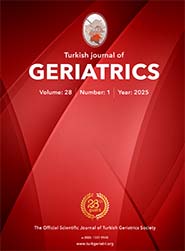2Ankara Dr. Abdurrahman Yurtaslan Oncology Training and Research Hospital, Department of Geriatrics, Ankara, Turkey DOI : 10.29400/tjgeri.2025.417 Introduction: Bone marrow biopsy is widely used for the diagnosis of hematological diseases and malignancies that increase with age. We aimed to show the contribution of bone marrow biopsies to the diagnostic process by comparing pathological diagnoses and clinical preliminary diagnoses in the patient group aged 65 and over.
Materials and Method: The study included 1,821 patients aged 65 and over who underwent bone marrow biopsy between 2019 and 2024. Clinical preliminary diagnoses, patient demographic information, and pathology reports of the departments requesting bone marrow biopsy were accessed through the patient information system. Pathological definitive diagnoses and clinical diagnoses were categorized and statistical analysis was performed.
Results: 30.8%(n=563) of the clinical pre-diagnoses were Multiple Myeloma, 18.5%(n=338) were Myelodysplastic Syndrome and 14.2%(n=258) were Chronic Myeloproliferative Disorders. Pathological examination was sufficient for diagnosis in 6.8%(n=124). Of these, 45.5%(n=772) were diagnosed with malignancy. Of the pathological diagnoses, 14.5%(n=265) were Multiple Myeloma, 7.4%(n=135) were Chronic Myeloproliferative Disorders and 2.9%(n=53) were diagnosed with Myelodysplastic Syndrome. When the diagnoses were compared, it was seen that there was a discrepancy rate of 38.1% (n=616). The highest discrepancy was in the Hematology department at a rate of 59.4% (n=366) and was statistically significant (p=0.024). The second highest discrepancy was in the Oncology department at a rate of 20.5% (n=126).
Conclusion: The high diagnostic discordance in clinics suggests that current diagnostic algorithms may not be sensitive enough. Our study showed that bone marrow biopsy should be performed in patients aged 65 years and older based on accurate clinical indications and that new diagnostic protocols should be focused on development.
Keywords : Bone Marrow Examinations; Aged; Pathology
